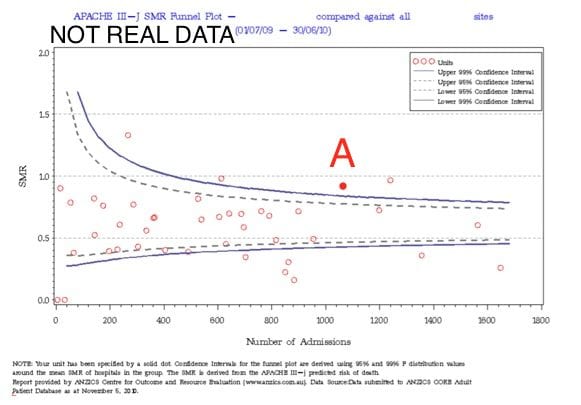CICM SAQ 2015.2 Q24
Question
As part of a nationwide quality improvement program, the standardised mortality ratio (SMR) of your Intensive Care Unit was compared to other similar Intensive Care Units using a funnel plot.
You are ICU “A” (filled red dot)
- a) What does the graph show about your ICU “A”? (20% marks)
- b) Explain how the SMR is calculated. (20% marks)
- c) Give the causes of an increased SMR. (60% marks)
Answer
Answer and interpretation
a) What does the graph show about your ICU “A”? (20% marks)
The SMR of ICU A is above the upper 99% CI indicating the SMR is significantly higher than similar
hospitals. Your ICU has significantly more deaths than expected compared to similar hospitals.
The overall SMR for the group is less than 1 and the SMR for ICU A is less than 1
b) Explain how the SMR is calculated. (20% marks)
SMR = O/E
O= observed number of deaths, E = expected number of deaths
E is derived from the average of the sample/ population.
Usually a risk adjustment model is used to calculate and account for severity of illness.
c) Give the causes of an increased SMR. (60% marks)
- Can be “apparent” or “real”.
- Data quality
- Incomplete or errors in data submission causing underestimated expected risk
- Widely different casemix of this ICU compared to others.
- Statistical model (risk adjustment) may no longer well calibrated
- True increase in mortality which can be due to
- i. Factors internal to ICU: very high occupancy, poor processes,, inadequate staffing
- ii. Factors external to ICU; problems in services that are high users of ICU e.g. surgery, system
- Pass rate: 27%
- Highest mark: 6.5
Additional Examiners’ Comments:
- Many candidates showed a significant knowledge gap relating to this commonly used quality indicator with insufficient details and structure in their answers.

Examination Library
CICM
Chris is an Intensivist and ECMO specialist at The Alfred ICU, where he is Deputy Director (Education). He is a Clinical Adjunct Associate Professor at Monash University, the Lead for the Clinician Educator Incubator programme, and a CICM First Part Examiner.
He is an internationally recognised Clinician Educator with a passion for helping clinicians learn and for improving the clinical performance of individuals and collectives. He was one of the founders of the FOAM movement (Free Open-Access Medical education) has been recognised for his contributions to education with awards from ANZICS, ANZAHPE, and ACEM.
His one great achievement is being the father of three amazing children.
On Bluesky, he is @precordialthump.bsky.social and on the site that Elon has screwed up, he is @precordialthump.
| INTENSIVE | RAGE | Resuscitology | SMACC

